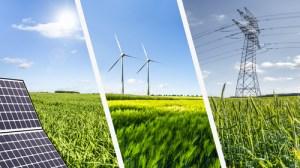By Joel Nelson on December 30, 2020 in Energy
Here’s a roundup of recent reports from the Energy Information Administration, the statistical and analytical agency within the U.S. Department of Energy:
Wind power flies high in 2020
Project developers expect more than 23 gigawatts of wind turbine generating capacity to come online in the U.S. in 2020, far more than the previous record of 13.2 GW added in 2012.
The impending phase-out of the full value of the U.S. production tax credit at year’s end is leading to more capacity additions than average this year, just as previous tax credit reductions led to significant wind capacity additions in 2012 and 2019.
Texas has the most wind turbine capacity among states, with 29.1 GW installed as of August 2020 and another 4 GW expected by the end of the year.
Wind’s share of U.S. electricity generation increasing from 7.4% in 2019 to 8.8% in 2020 — more than any other renewable electricity generation source. That share is expected to reach 10.3% in 2021.
CO2 emissions reach lows
In 2020, carbon dioxide emissions from the U.S. energy sector could be 11% lower than in 2019, according to data collected through August and estimates through December. CO2 emissions are expected to fall by 19% for coal, by 13% for petroleum and by 2% for natural gas.
Many of this year’s changes in energy-related CO2 emissions are attributable to COVID-19, including working from home, stay-at-home mandates, closed or limited operating hours for several types of businesses and travel restrictions. In April, monthly U.S. energy consumption fell to a 30-year low and emissions reached a record low.
Winter bills holding steady
U.S. households that primarily use natural gas or electricity will have slightly higher energy expenditures this winter, with households using propane spending 14% more and those relying on heating oil saving 10%.
The National Oceanic and Atmospheric Administration forecasts a colder-than-usual winter. The number of people working and attending school at home will further increase home heating.
Natural gas is the most common space heating fuel in 28 states and the District of Columbia. Electricity tends to be more common in Southern states. Heating oil is more common in the Northeast than in other regions and is the most prevalent primary heating fuel in four Northeastern states. Propane is more common in the Midwest but isn’t the most prevalent heating fuel in any individual state.
Pennsylvania tops electricity export list
Electricity generation exceeds electricity consumption in 25 U.S. states and almost 10% of electricity generation is traded among states. California’s net electricity imports, 25% of its total supply, were the largest in the country in 2019. Pennsylvania exported the most, 24% of its total supply while Texas generated the most electricity.
California utilities partly own and import power from several power plants in Arizona and Utah. The state’s electricity exports include hydroelectric power from the Pacific Northwest.
Nuclear remains prominent
Nine of the 10 U.S. power plants that generated the most electricity in 2019 were nuclear plants. These 10 plants generated a combined 230 million megawatthours (MWh) of electricity that year, accounting for 5.6% of the country’s electricity generation.
The makeup of power plants that generate the most electricity has shifted in the past 10 years from a mix of nuclear and coal plants to almost all nuclear in 2019. In 2010, coal’s share of U.S. electricity generation was 45%, compared with 23% in 2019.
Fires’ smoke clouded solar power
In the first two weeks of September 2020, solar-powered generation in the California independent System Operator, which covers 90% of utility-scale solar capacity in California, was 13.4% lower than at the same time a year ago and nearly 30% from the July 2020 average, despite growth in installed solar generating capacity. That’s because small particulate matter particles contained in smoke from wildfires burning across the state reduced the amount of sunlight that reached solar panels, decreasing solar-powered electricity generation.
Most of California’s solar capacity is in the southern half of the state and the largest wildfires were concentrated in the northern and central regions. Offshore winds pushed wildfire smoke into Southern California.
Read about Yardi software solutions that promote energy efficiency for commercial and residential properties.


